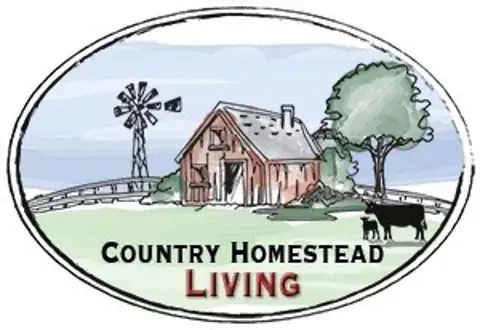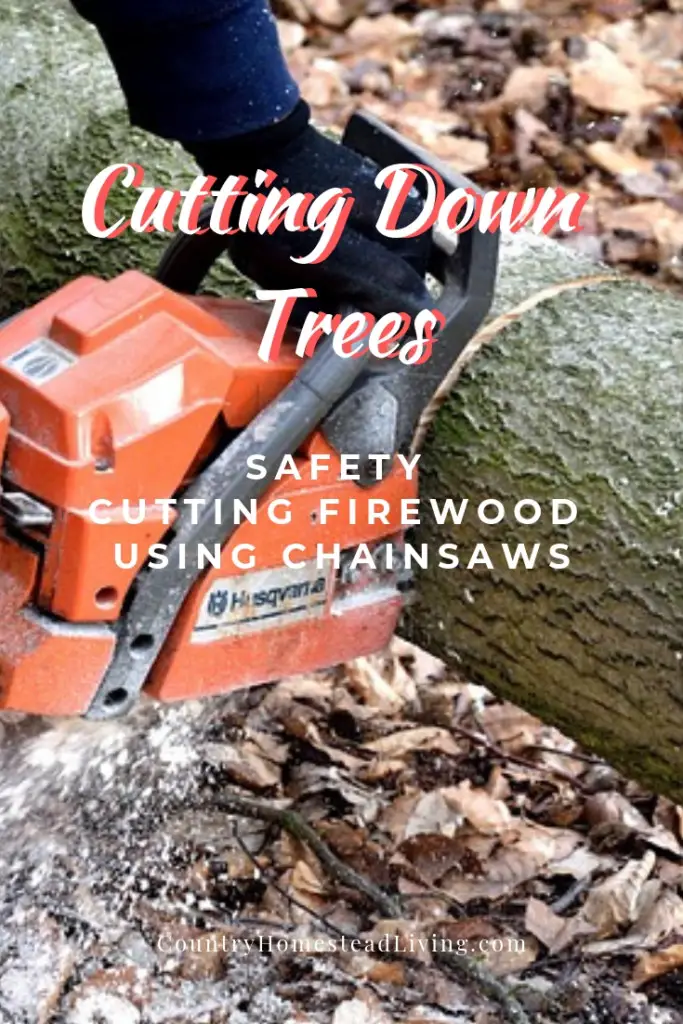If you heat with wood, you either buy your firewood or you learn to harvest your own firewood.
I have 38 years experience cutting down trees without a single injury.
I’m going to provide details of what I have gained from my knowledge and experience so you too can harvest your own trees for firewood safely.
To explain how to safely cut down trees for firewood using chainsaws, we will be looking at several aspects.
Determining which way a tree will fall, the proper way to plan an escape route when the tree starts to fall.
Also how to safely turn the tree into firewood, avoiding getting the chainsaw caught in a bind, and avoiding surprise dangers when cutting firewood.
Cutting down trees can be dangerous.
I know people who were seriously injured when cutting down trees.
When I worked as a Health Care provider I treated several people who were injured because they did not follow simple safety rules when using a chainsaw.
This article will teach you how to be safe when cutting down trees and turning them into firewood.
Necessary Tools
- Chainsaw with gas/oil mix (2-cycle oil) and bar oil
- Hand file for sharpening chain in the field
- Scwrench or screwdriver and socket wrench
- Safety equipment for sawyer; goggles, chain saw chaps, hard hat, ear protection, boots preferably steel toed (links to read reviews on Amazon)
Nice To Have Items
- Axe or cant hook (links to read reviews on Amazon)
- Steel or plastic wedges (links to read reviews on Amazon)
- Rope or chain, come a-long (link to read reviews on Amazon) or vehicle with winch
- First Aid Kit
- Cell phone or Two Way Radio if no cell service
Which Way Will The Tree Fall When Cut
Which way the tree will fall is determined by more than just how it is cut.
Beginners in tree falling seem to think that if you notch the tree and make your back cut that the tree will fall in the direction that it was notched.
That is not always the case.
Before even starting up the chainsaw, you need to take a good look at the tree to determine which way it will fall.
Many times the direction it will fall has more to do with the tree itself than how it is notched and back cut.
Also look for widow makers, large dead limbs that may be hanging from or in the tree.
Do not stand under them at any time!
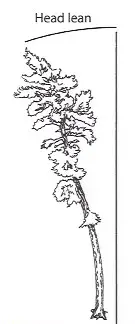
Look at the tree from all sides.
Does it lean one direction?
Pay special attention to the crown of the tree.
If the crown leans, the tree will likely fall in the direction the crown leans.
If the tree appears to be growing straight up, pay special attention to the limbs.
Are there more limbs or bigger limbs on one side or are they seemingly equal all around the tree?
If there are more limbs or bigger limbs on one side than on another, there is a very good chance the tree will fall in the direction of those limbs.

Pay attention to the wind.
In the woods, wind is less near the ground than it is 20′ up.
Take into consideration the direction the wind is blowing.
How will it affect the direction the tree will fall when it is cut?
If the wind is gusty or over 15 mph it is the better part of valor to plan your wood cutting for another day!
Once you have determined which way the tree will likely fall, is there anything that the tree might hit or hang up on?
More than one aspiring woodsman has cut down a tree only to have it take down the electrical wires he thought were too far away to be a problem!
I’ve avoided this problem but know others who weren’t so successful.
Even experienced woodsmen can occasionally have a tree fall up to 45 degrees to one side or the other of where they planned for it to fall.
So take a good look around to know what the tree might hit or take down before starting to cut down a tree.

Occasionally a woodsmen will cut down a tree only to have it hang-up on the branches of another tree and refuse to fall to the ground.
Now you have a real problem.
The problem is even bigger if the tree is in an area where kids might play in the woods.
At some later time that tree may come crashing to the ground, just as kids were playing under it.
How do you handle a hang-up?
Small diameter trees, say 12″ or so may be removed by carefully making a cut in the trunk no higher than the woodsman’s shoulder height.
Before cutting, determine which is the best side to stand on.
Stand on the side of the tree that it has the least chance to roll or fall towards.
One or two cuts this way may help the tree to fall free.
Another way of handling a hang-up is to use a cant hook (link to read reviews on Amazon).
Stand on the side of the hang up tree that it has the least chance of falling or rolling toward.
Hook the cant hook onto the tree near where the tree touches the ground.
Then push the cant hook so you are rolling the tree away from you.
This can release trees that are hang ups and are 12″ or so in diameter.
If the hang up is a tree that is 14″ in diameter or larger, it is very dangerous to try to cut it or roll it to bring it down.
Its best to attach a rope or chain to and pull the butt end, (end cut), away from the hang up.
A winch on a pickup truck or other equipment can do the pulling.
If there is nothing available with a winch, use a come along to pull the base of the tree away.
How To Properly Hold A Chainsaw
Chainsaws are not made in right hand and left hand models.
All chainsaws are made to be held the same way by right handed and left handed people.
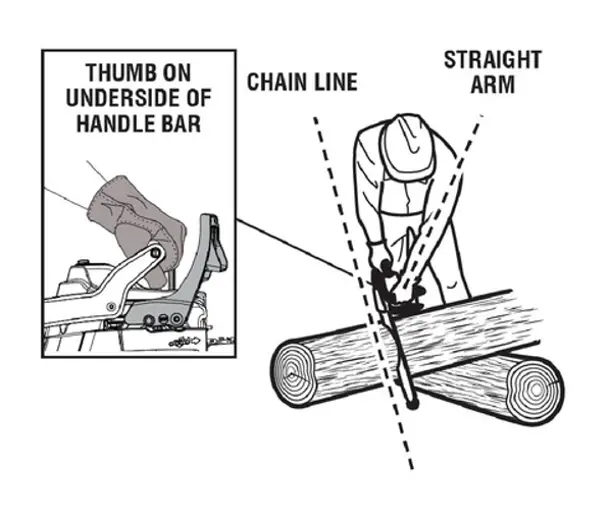
The handle with the throttle is always held with the right hand.
The left hand always holds onto the cross bar which goes from right to left across the saw.
Keep the left arm as straight as possible so chain line is to the right of your body.
This helps give you protection from kickbacks. (discussed below)
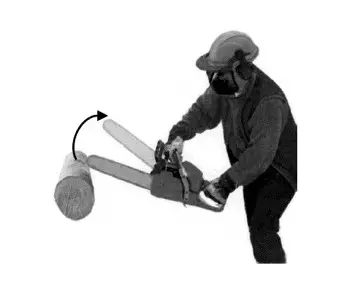
If you hold a chainsaw wrong, left hand on throttle and right hand on cross bar, a kickback will throw the saw right toward you!
Do not try cutting by holding a chainsaw in just one hand.
You will not have good control of the saw.
A kickback or other surprise move of the chainsaw has a much greater chance of harming you than when you hold the saw properly!
Planning An Escape Route
Before beginning to cut down a tree, clear the underbrush and small trees that are in the way or that would keep the sawyer from being able to use a safe escape route.
Plan the escape route before beginning to cut down the tree.
The best escape routes are at a 45 degree angle from the opposite direction of the planned fall.
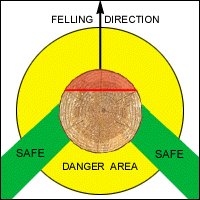
When the tree starts to fall, place the saw on the ground and use your planned escape route.
Do not take your planned escape route with a running chainsaw in your hands!
You have a much greater risk of being off balance and falling when carrying your chainsaw as you take the escape route.
Using an escape route is a safety feature that has kept many a woodsman from injury if a tree twisted before falling or fell the opposite direction than what was planned.
Trees twisting and trees falling the opposite direction of what was planned are things that can happen.
If they do, you’ll be glad to have had a clear escape route planned ahead of time.
Falling The Tree
You have determined which way the tree will fall.
You have cleared the planned escape route.
You have made sure there is nothing the tree will take down or hang up on. Now it is time to fall the tree.

First, begin by making a horizontal cut on the side of the tree in line with the direction you want the tree to fall.
This cut is also called the Gunning Cut.
Cut 1/3 of the way through the tree’s diameter in a straight, horizontal line.
Second, make the face cut, also called the sloping cut or undercut.
This is a 45 degree cut beginning above the horizontal cut and ending at the termination of the horizontal cut 1/3 of the way through the tree.
Start this cut about the same distance above the horizontal cut as the horizontal cut is made into the tree.
Last, make the backcut.
The backcut starts on the opposite side of the tree from the horizontal cut and about 2″ above the level of the horizontal cut.
Continue the backcut until it reaches a point about 2″ above and 2″ back from the termination of the horizontal cut.
Like the horizontal cut, the back cut is a level cut and does not slope up or down.
The 2″ left, or 1/10 of a 20″ diameter tree, when the backcut is complete is called the stump shot.
This helps prevent the tree from falling backwards.
The backcut must not be continued so no holding wood remains.
If the backcut is not exact, if the backcut goes all the way through the tree on one side the tree will twist and fall to the side which still has some holding wood.
Once the three cuts are completed, it is not uncommon to hear some cracking sounds and for the tree to slowly lean the direction you intend for it to fall.
Then for it to fall with a crash to the ground.
When the tree starts to lean, it is time to set the chainsaw down and use your planned escape route to move away from the falling tree.
Before making the backcut take one last look around.
Be sure no one or anything has moved into the anticipated area where you want the tree to fall.
Caution: Never try to cut holding the chain saw higher than your shoulders.
You do not have good control of the saw when doing this.
This would be the time that the saw kicked back and injured you or a portion of the limb being cut fell on you and injured you.
How To Safely Turn The Tree Into Firewood
When you start to cut up a tree into firewood you are now doing what is called bucking the tree.
If you start with the limbs you are over bucking.
If you start with the trunk you are under bucking.
Once the tree is lying down on the ground, you can begin bucking it into the lengths needed for firewood.
The most common firewood length is 16″.
This length usually fits well into any wood burning stove that is rated to heat 1500 square feet or more.

Before starting to cut up the tree, stop and take a good look at how the tree is lying on the ground.
Are there any small trees that are bent and caught under the fallen tree?
These are called spring poles.
As a health provider I once helped treat a woodsman who missed noticing a spring pole.
He absent mindlessly cut it where it disappeared under the downed tree.
That was a big mistake!
This spring pole sprang loose and came up with such force that when it hit him in the forehead it actually picked him up off the ground and landed him on his back.
He was out cold. Fortunately the chainsaw landed away from him.
A friend helped him to the truck when he came to and drove him to the hospital.
The spring pole had fractured his skull and opened a cut about 4″ long across his forehead that went all the way down to his skull.
He was lucky. If the spring pole had hit him just an inch lower he could have ended up with two ruptured eyes and been blind.
Always look carefully for spring poles!
Notice which way they will spring back when properly cut.
The proper way to deal with a spring pole is to stand back as far as possible while making a series of shallow cuts about 1/2″ apart on the compression side.
When the wood starts to pinch the saw, remove it and make the next cut.
After making 4 to 6 cuts, the release cut is made 1/2″ toward the smaller end on the tension side.
Stand back as the tension is released.

This is a good place to define tension and compression.
These are the two components that can cause the wood to either bind or pinch the chainsaw’s chain when cutting or to cause the wood to fall free when cut.
The direction of these pressures determine the cutting technique that needs to be used when cutting wood.
Compression is where the tree or log is in a position where the wood fibers are being pushed together.
Tension is where the tree or log is in a position where the wood fibers are being stretched.
When a tree or log is in a position that exerts compression on it, tension is the force acting on the opposite side of that tree or log.
Likewise, if a tree or log is in a position that exerts tension on it, compression is the force acting on the opposite side of that tree or log.
If you begin cutting on a downed tree or log and the wood binds the chain, you were cutting on the compression side.
It was the forces pushing the wood fibers together that caused the chain to bind.
After downed trees are bucked up, split larger logs into pieces easy to hold in one hand.
Stack the wood and let it season. Seasoned firewood has cracks in the cut ends .
Types Of Binds
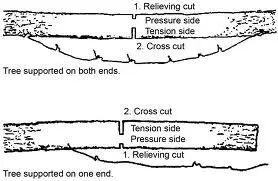
There are several types of binds.
A bottom bind is where the compression area is on the bottom of the log.
A top bind is where the compression area is on the top of the log.
A side bind is where a log is compressed on one side and tensioned on the other side.
An end bind is where a log is lying on a steep grade and gravity closes the bucking cuts.

When faced with one of these binds, you cut, if possible, from the tension side.
So in a bottom bind you cut from the top side.
In a top bind you cut from the bottom side, also known as an off side cut.
In a side bind you stand on the compression side and cut from the tension side, which is also an off side cut.
An off side cut is when you are cutting from the side opposite the side you are standing on.
An off side cut can also be when cutting from the bottom when it would be natural to cut from the top.
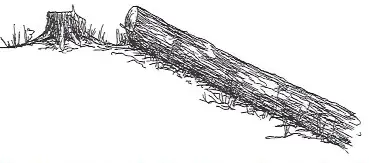
A log in an end bind can be a difficult log for you to cut!
If you have the means to do so, move the log to a less steep location.
Being careful not to have the log roll onto or into you or others.
If this is not possible, you may have to make a series of wedge cuts on the top of the log.
Then roll it over and make another series of wedge cuts opposite the first wedge cuts.
Then cut between the wedge cuts.

When falling a tree and making the backcut, if the tree settles backward it can bind the chain and bar.
This is called a sit-back.
It is usually the result of improperly determining which way the tree will fall.
Sometimes it is the result of the effect of wind on the tree.
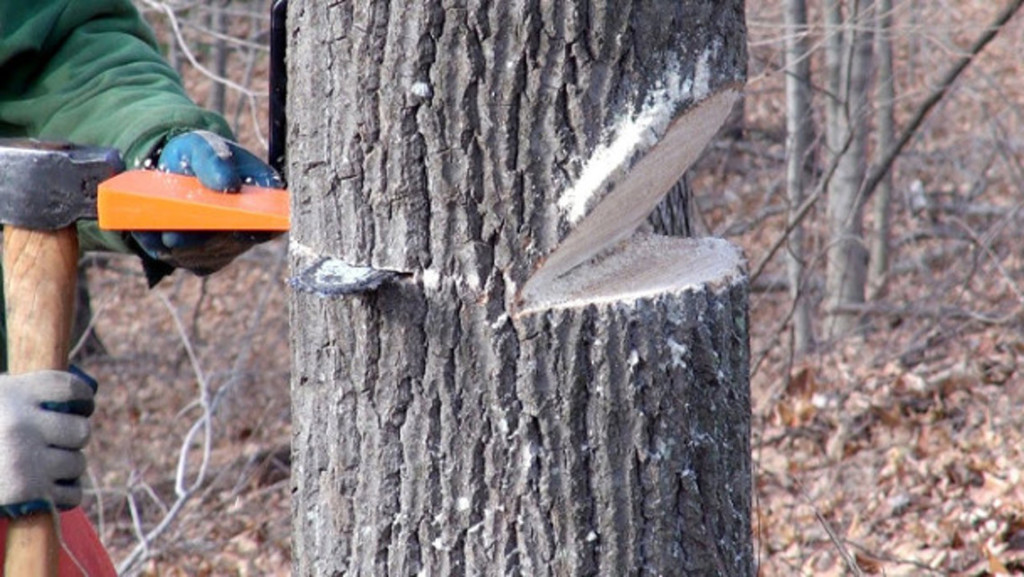
Unless care is taken in removing the saw from the sit-back, you can bend the bar necessitating a replacement bar before using the saw again.
If the backcut has not gone very far into the tree you might free up the saw by pulling and pushing it straight in and out while pulling it back out of the backcut to free the saw.
Turn the saw off before trying this!
If the backcut has gone further into the tree, placing a wedge (link to read reviews on Amazon) in the cut and using the back side of a single blade ax as a hammer may open the sit-back enough to carefully pull the saw free.
Sometimes it will be necessary to re-evaluate escape routes as if the tree will fall the opposite direction as planned.
Then use the ax or another chainsaw to carefully make a sloping cut to free up the saw.
The best way is probably to make a small sloping cut, just big enough to insert a wedge.
Then drive the wedge in just enough to relieve the sit-back and free the saw.
Sometimes using the wedge will move the tree back toward the original direction of the planned fall.
You may be able to drive the wedge in enough for the tree to fall the original planned direction.
This is best done when there is another person with you.
Before trying to do this you need to be sure there are sufficient escape routes for both of you.
Then one person pounds the wedge in while the other person watches the tree closely.
Stop between each hitting of the wedge for a second.
If the tree starts to fall, the observer alerts the other so they can both take there respective escape route.
Another way to fall the tree would be to drive the wedge in far enough that the tree now leans back in the planned direction of fall.
The back cut will no longer pinch or bind the chain.
Then a careful insertion of the chainsaw and extending the backcut forward can result in the tree falling the original direction.
Both of these last two methods have worked when in the last 38 years either I or someone else has experienced a sit-back.
These can be very dangerous situations that must be handled carefully and with the safety of all involved as the primary concern.
Over Bucking
If you start bucking at the crown or limb end, there will be limbs that can be cut into firewood.
Some woodsmen remove the limbs that are too small for firewood first.
After cutting those too small limbs, they are thrown clear of the other tree limbs so as to not cause the sawyer to fall or twist an ankle if he steps on them.
Next the limbs that are large enough for firewood are cut. starting at the small end of the limbs cutting no higher than the sawyer’s shoulders.
The limbs are cut into firewood length pieces ending at the tree’s trunk.
When the cut pieces create a hazard about the sawyer’s feet, he stops and removes the hazard.
Either set the chain brake or turn off the saw when doing this.
Once the limbs are cut up into firewood lengths, the sawyer starts on the trunk of the tree.
Be extra careful when cutting limbs that may be keeping the tree from rolling.
It is better to leave these limbs intact and start cutting the trunk into firewood length pieces starting from the butt end of the tree.
The butt end is where the cuts were made when the tree was felled.
When you have bucked the tree up to where there was a limb keeping the tree from rolling, it is OK to cut that limb up into firewood lengths and off of the trunk now.
This way there is not the large trunk below that limb to roll and cause problems.
Under Bucking
This is where the sawyer starts bucking the tree into firewood lengths starting at the butt end of the tree.
One potential advantage of under bucking is that you do not accidentally cut a limb that is keeping the tree from rolling and causing a problem because the trunk can roll and possibly injure you or someone else.
Some woodsmen prefer to cut the trunk into 3 or 4 long pieces first.
They make sure they are not standing downhill from the tree before beginning to cut.
Next they make cuts firewood length apart and half way through the long pieces of tree trunk.
After rolling that section of trunk over, they finish cutting it into firewood lengths.
Some woodsmen use a cant hook (link to read reviews on Amazon) to turn the lengths of trunk over before completing the cuts.
A cant hook is a tool that has a handle and a hooked arm and a toothed metal cap on one end. It is used to roll logs over.
If a downed tree has the roots attached, do not cut the root end off when standing down hill of the tree!
The root end can roll on you!
Once you reach the limbs, clear out those limbs that are too small for firewood first and toss them away from the rest of the tree.
Then, as you come to them, cut the limbs into firewood lengths as long as you do not have to cut higher than your shoulders.
If a limb is above shoulder height but still big enough for firewood, cut it off at shoulder height.
Lay it across one of the firewood length pieces of trunk to cut it without the chance of the bar hitting dirt or rocks and dulling the chain.
Cutting Down The Stump
I like to cut the stump as close to ground level as possible without the bar and chain getting into the dirt.
I will make a horizontal cut about 2″ above the dirt level and cut half way through the stump.
Then I move to the other side and make a second horizontal cut that meets the first one.
If there is dirt on the stump where I need to make a cut.
I brush it off with a gloved hand before I begin the cut.
Then I lay the stump on its side when it is longer than 16″ and make firewood length cuts about half way through it.
Next I roll the stump over and finish cutting the stump into firewood lengths.
This keeps the bar and chain away from the dirt and rocks that can dull it.
Surprise Chainsaw Dangers To Be Aware Of
There are three specific dangers that can arise when using a chainsaw that all users should be aware of.
Knowledge of these dangers and what to do makes using a chainsaw safer for all involved.
Kickback
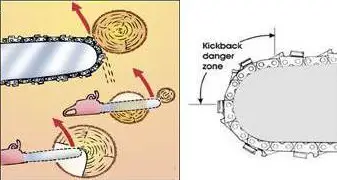
A kickback can happen when the top corner of the chainsaw bar’s tip hits something when cutting.
It can be a limb that the sawyer can’t see from where he is standing.
It could be another piece of wood or a rock that the tip of the saw touches while making a cut through a downed log.
When this happens there is a sudden kickback towards the sawyer.
The saw can literally come back and hit the sawyer causing serious injury.
Prevention: Keeping a firm hold on the saw with both hands at all times.
Being constantly aware of where the bar’s tip is and what is around it.
By keeping the left arm straight when using a chainsaw this moves the chain line where a kickback should be to the right of your body.
When a kickback occurs immediately release the throttle.
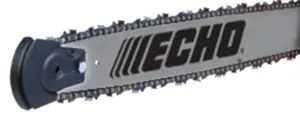
If you are bucking firewood that is smaller in diameter than your chainsaw bar is long, a kickback guard on the tip of the bar prevents kickbacks.
This guard is easy to put on and remove and is standard equipment with Echo Chainsaws but costs extra with Husqvarna and Stihl chainsaws.
Pull-in
A pull-in can happen when the chain on the bottom of the bar suddenly gets caught or pinched.
This can stop the chain’s movement but not the saw’s movement.
The chain moves clockwise on the bar.
It goes away from the saw on the top of the bar and toward the saw on the bottom of the bar.
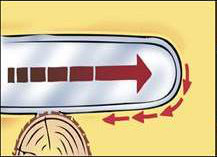
So when the chain is caught or pinched on the bottom of the bar, the saw is pulled in toward the log.
If the sawyer is reaching forward to cut, he can be pulled off his feet or at least off balance by a pull-in.
Prevention, always have a comfortable stance when cutting with a chain saw.
Be close enough to the log that the chainsaw body will just clear the near side of the log when cutting.
This limits the distance the chainsaw can move away from you in a pull-in situation.
If you detect a pull-in, release the throttle immediately.
Be aware that when cutting down on the compression side of a log, a pull-in can be caused by a bind.
Always have both hands firmly on the handles.
When cutting a log you will cut faster by using the portion of the bar closest to the saw.
If your saw has dogs on it, metal teeth pointing out from the saw on one side or on each side of the bar, use the dogs to help move the saw through the wood.
Push-back

A push-back is the reverse of a pull-in.
This occurs when cutting the underside of a log .
When the underside of the log is in compression it can bind the chain on the top of the bar.
This stops the chain but the momentum will push the saw back toward the sawyer.
This can knock the sawyer down or at least put him off balance.
Prevention, always have a good comfortable stance with both feet firmly on the ground.
Before letting the saw touch the log, move or kick away anything that keeps your feet from being firmly on the ground.
If you detect a push-back, release the throttle immediately.
Be sure to always have both hands firmly on their respective handles.
Be constantly aware of which side of a log is in compression or tension.
Push-back occurs when the bottom of a log is in compression.
When you know you are cutting on the compression side of a log, you can be aware of the possibility of a bind and how it will affect the saw.
Be prepared for it if it happens.
Related Questions
What if some of the cut pieces of firewood are too heavy to carry to the truck or trailer?
In this case I would split them in half or quarters before carrying them.
You could use the ax or a splitting maul.
Some splitting mauls have a sledge hammer side on them that can be handy.
What if the chain gets dull or loose or comes off during cutting?
You sharpen the chain with a hand file, tighten the chain, and replace the chain if it comes off the bar.
How to do these adjustments easily is covered in detail in the article on chainsaws I wrote titled, “Chainsaw User Guide (Pro Grade, Cost, Bar, Chain, Maintenance).”
How does one use a come-along to remove a tree that is a hang-up?
Place a rope or chain, I use a strong rope, around the base of the hang-up.
Find another tree about 35 or 40 feet away that can be used as an anchor to pull the tree free of the hang-up.
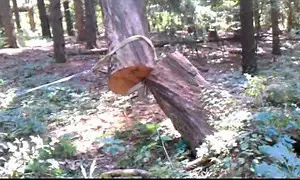
I also have a chain with a bolt, washers and nut that can be placed around the anchor tree, the ends fastened together and then hook the back hook of the come a-long over this chain.
Next, with the come a-long cable extended out as far as it will go, tie the rope onto the front hook of the come along.
Be sure the rope is taunt when tied to the come-along front hook.
Winch the tree with the come a-long. In most cases the tree will fall free without having to remove the rope and extend the come a-long cable again.
If it does not fall free, extend the come a-long cable, re-tie the rope and winch a second time.
